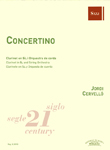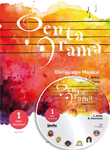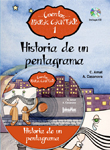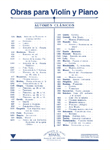Quartet Sant Petersburg
Cuarteto de cuerda
CERVELLÓ, JordiReg.: B.3664
30,65 €
P.V.P. (VAT included 4%)
Add to cart
- Ensemble: Quartets: .
- Genres: Classical / contemporary: Chamber.
- Product format: Partitura + particellas
- Difficulty level: Advanced-superior
- Period: 2nd half S. XX - XXI
- Publishing house: Editorial Boileau
- Collection: Siglo XXI
- No. of pages: 64+72
- Measure: 31,00 x 23,00 cm
- Lenght: 28'
- ISMN: 979-0-3503-0904-5
- Available in digital: No
- Available for rent: No
The Saint Petersburg Quartet was written between January and March 2011. It owes its name to the fact that Saint Petersburg has been a very significant city for me. I was invited there in 1988 to take part in a big contemporary music festival, but my uninterrupted bond with the city started on 2002, thanks to the negotiations of my friend and pupil Albert Barbeta. Since then, I have constantly travelled there in order to record a considerable part of my repertoire: seventeen pieces. In addition to the concerts we went to, I took the opportunity during my trips to visit the well-known conservatoire where so many great personalities from the world of music composition once taught, and the place that launched the most important violin school in the whole of Russia, the school of Leopoldo Auer. Spending a long time in Auer’s classroom writing my concert for violin and orchestra was an unforgettable experience for me. His large portrait motivated me even further.
Saint Petersburg Quartet evokes many of the most cherished and moving moments that I have had in this city. It is structured in four movements. The first one, Allegretto-Allegro, opens with an introduction that sets forth the two main themes, amid a soft and elastic atmosphere. The Allegro starts vigorously and in it we find changes in the tempo and moments of mystery, as well as a certain seclusion, returning then to the emphatic theme where the counterpoint finds its place. The movement ends placidly.
The Scherzo-marcato that follows is marked by a persistent rhythm of triplets that carries on from beginning to end. The tempo does not change, but brief and decided themes are introduced, as well as passages of counterpoint. Brief and dissonant chords are heard throughout the movement, which ends vigorously.
The third movement, Ut, is a very special one. For a while already I had been playing with the idea of writing a movement that was to have the tonality C as a leitmotiv. This one is made up by two slow parts. Both static. In the first one, the first violin plays pizzicatti-glissandi. In the second, the first violin and particularly the violoncello settle on C while the other two instruments produce descending chromatic harmonies.
The third movement, titled Ut, is very special because of the atmosphere that the players must create. Although the first, second and fourth movements are written in a specific tempo, Ut is completely different. It is completely static and must be played with great delicacy. The movement begins with an Adagio without any metronome indication. In measure 30 another section begins in which the note C acts as a leitmotiv—a pedal note which continues to the end. At this point I have written a metronome indication of 46 for the half note along with Italian expressive indications— lontano, sempre delicato ed appena vibrato. The First Violin and the Cello maintain the C while the Second Violin and the Viola play descending chromatic harmonies. My intention was to transport the listener to a silent world without the least tension. Everything is piano, with one, two or even three p. The movement should be played as if time stands still and from a great distance. We are not in our own, real world.
Finally, the Introducció-Presto (the Introduction-Presto). It starts with some bucolic passages which remind us of the introduction to the first movement. A fast and energetic Presto suddenly erupts. A kind of moto perpetuo which alternates with two expressive passages and, towards the end, a viola and violoncello tremolo, all of great mystery and expectation, make way for a resounding finale marcato.
Jordi Cervelló
II Scherzo-marcato
III Ut
IV Introducció - Presto









